Modular Construction
Prefab 2.0 to the Rescue: New Modular construction methods may help fix the global housing crisis.
![]() Continuing Education
Continuing Education
Use the following learning objectives to focus your study while reading this month’s Continuing Education article.
Learning Objectives - After reading this article, you will be able to:
- Explain why prefabrication can offer improved worker safety and better quality, along with cost savings and shortened project timelines, when compared to traditional construction methods.
- Discuss the potential for prefabrication as a solution for the global housing crisis.
- Describe volumetric and flat-pack prefabrication methods and discuss the kinds of projects and typologies that are best suited to each.
- Describe strategies for reducing the amount of work performed on-site.
View course on architecturalrecord.com »
For generations, prefabricated housing has had a bad rap. Visions of ticky-tacky buildings in identical rows with no connection to context pushed modular construction to the fringe. But with global population increasing, the middle class rapidly expanding, and household size shrinking, some 2 billion new homes will be needed by the end of the century. That far outstrips what current construction methods can supply.
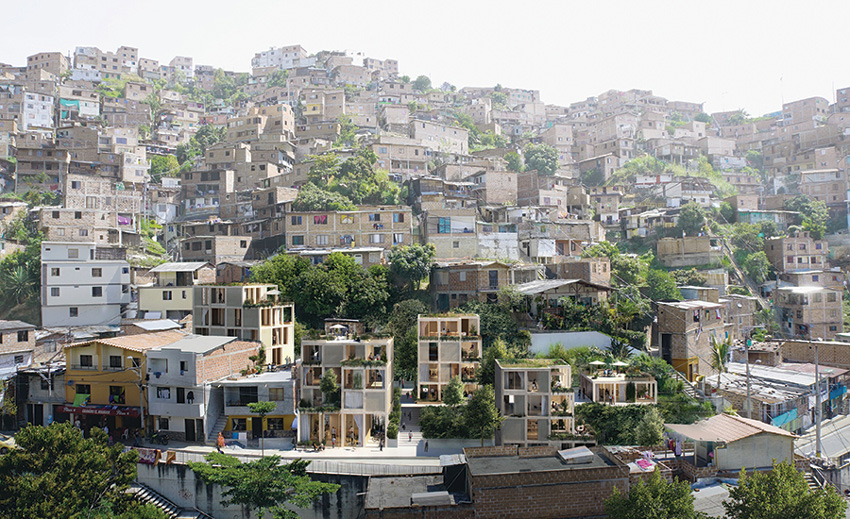
RENDERING: COURTESY EFFEKT ARCHITECTS/SPACE10
The Urban Village Project is a concept for flat-pack mass-timber housing created by IKEA’s research and design lab with EFFEKT Architects.
At the same time, because nobody wants climate-related population attrition to solve the housing problem for us, greenhouse gas emissions from building construction and operation (currently 40 percent of global emissions) will have to be slashed. And considering that only 7 percent of the world’s population can afford to own a home under current financing structures, something’s got to give.
Across the housing sector—and the construction industry more broadly—hopes of salvation through prefabrication are surging. “The ambition is to resolve the housing crisis with affordable, livable, and sustainable solutions,” says Sinus Lynge, a partner with Copenhagen-based EFFEKT Architects. EFFEKT’s comprehensive concept for flat-pack housing, developed with SPACE10, the research and design lab of archetypical modular furniture fabricator IKEA, launched earlier this year.
Optimism around prefab’s potential to jump-start construction’s stalled productivity is based on several key advantages. These include the scope for technological innovation; the potential for economies of scale; and the ability to deliver projects as much as 80 percent faster, with improved safety and quality control, higher environmental performance, and reduced risk. “We’re completely redefining the way buildings are conceived and realized,” says Craig Curtis, chief architect at Katerra, an off-site construction company founded in 2015, which last year acquired Atlanta-based Lord Aeck Sargent and Vancouver-based Michael Green Architecture (MGA), and this year became North America’s largest mass-timber manufacturer. “We’re using technology in new ways to design, engineer, and configure, own the supply chain, tie data to a robust technology backbone, and assemble projects in the field,” says Curtis.
And while Katerra may be unique in the degree to which it is taking charge of its supply chain, a thorough engagement across previously siloed project constituents is a hallmark of contemporary prefab. “It has massive potential to change not only the way we build, but the way teams work together,” says Tim Swanson, architect and chief design officer at Skender, a 64-year-old construction firm that last year shifted to a prefabrication-oriented business model. Ranked by Fast Company as one of 2019’s most innovative companies, Skender began production at its new Chicago manufacturing facility earlier this year.
With vertically integrated design, engineering, fabrication, and construction, Swanson says “there can be concern around what that means for us as architects.” Referring to such luminaries as Eileen Gray, Ray and Charles Eames, Marc Newson, and Karim Rashid, he says, “We as a design industry don’t look down on them because they produce things that are manufactured. In fact, they were and are able to push the bounds of design and materiality because of these fuller integrations.” At Skender, Swanson finds that daily conversations across disciplines are resulting in the kind of integration that, historically, has proven fundamental to propel design forward.
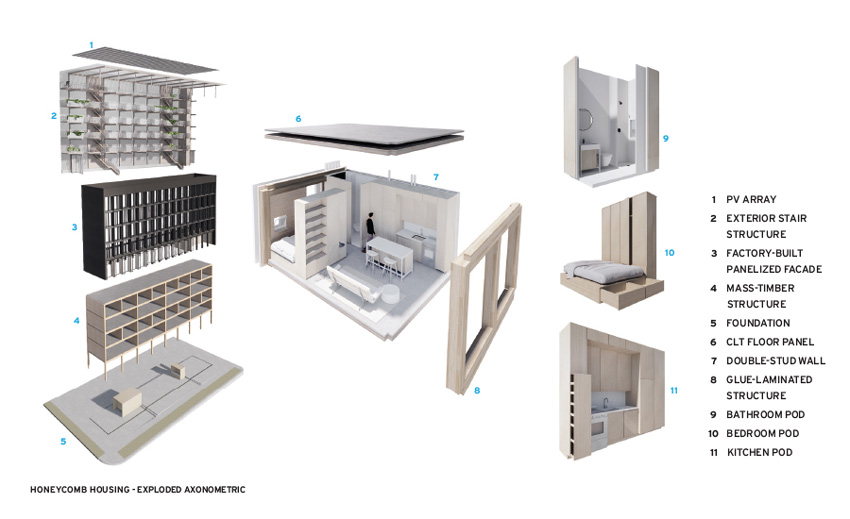

IMAGES: COURTESY MICHAEL GREEN ARCHITECTURE
The 32-unit Honeycomb Housing Prototype, which Michael Green Architects has developed for a site in Austin, comprises five stories of flat-pack mass-timber construction on a concrete podium.
Integration has also led to the exploration of new tools and techniques, such as 3-D printing and robot-guided construction. On Skender’s paperless production line, instructions to the manufacturing floor feed directly from architectural and engineering CAD models. At Katerra, robots perform such tasks as maneuvering large-format sheathing panels onto framed walls, and cutting and fastening them with precision. In response to concerns that increasing automation may eliminate jobs, “I would argue that the demand for housing is beyond what can possibly be provided for using the systems we have available today,” Curtis says. “If we can improve the output per employee by using automation, it doesn’t necessarily reduce the number of jobs—it makes every job more effective.”
Although Katerra and Skender share a faith in the capacity of modular construction to tackle the housing crisis, they take contrasting approaches. Katerra exemplifies a flat-pack strategy, fabricating building elements such as structural frames, cladding panels, and systems-integrated floor, ceiling, and roofing panels, and shipping them as kits of parts to be assembled on-site. Skender takes a volumetric approach, in which three-dimensional modules of enclosed space are factory built and finished (right down to the TV on the wall, in the case of furnished units), and then stacked and connected on-site.
Flat-pack systems typically allow for greater flexibility and customization than volumetric modules, which are constrained by the dimensions that will fit on a truck. Volumetric modules, which in North America have been the more common method thus far, entail less site work, and so offer potentially greater efficiencies—especially if a factory floor where it’s 65 degrees and sunny year-round contrasts favorably with what’s outside.
With the exception of student and micro-housing, where small unit size and a high degree of standardization are well-suited to volumetric modules, a hybrid of flat-pack and volumetric systems will probably turn out to be optimal, says Michael Green, a principal at MGA. The firm’s Honeycomb Housing Prototype, a 29,300-square-foot development with 32 units, now in design for an urban infill site in Austin, Texas, provides an example.
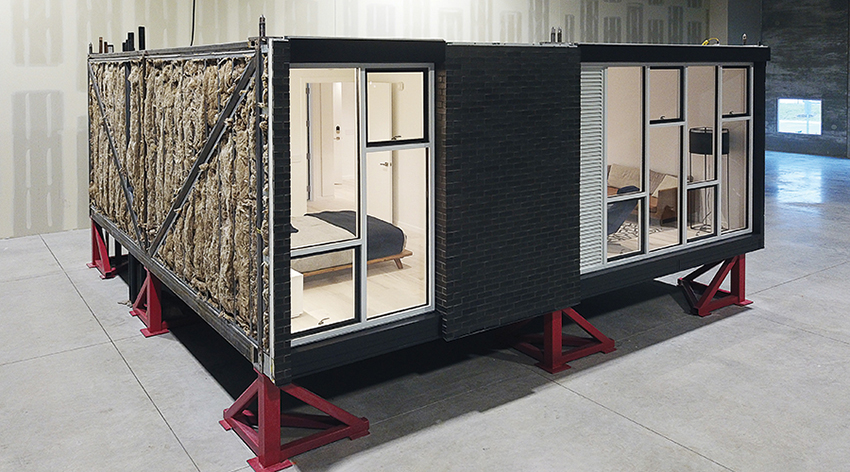
VANCOUVER AFFORDABLE HOUSING AUTHORITY/MARK SIMPSON
Chicago-based Skender relies on steel-framed modules for its system, which is self-supporting up to 12 stories.
The project comprises five stories of mass-timber modular construction on a concrete podium. The flat-pack portion consists of CLT panels and glulam frames. The panels, with integrated acoustic insulation and m/e/p systems, are exposed on the underside as a structural wood ceiling and finished on top with a polished concrete floor. A panelized factory-built wood facade system and CLT-based composite roofing panels enclose the structure. Within the dwelling units, bathroom, bedroom, and kitchen pods are standardized to be factory built as volumetric modules and craned into place.
For Green, the best prefab doesn’t necessarily look prefab. “The whole point of a lot of the new technology is to move towards mass customization—not towards a highly repetitive world covered in Levittown-like housing, which is what people fear when they hear ‘prefabrication.’ ”
Whether flat-pack, volumetric, or hybrid, off-site fabrication of superstructure concurrent with site work, followed by ultra-speedy on-site assembly, shaves months off a project schedule compared with conventional construction. Skender can produce a fully finished module—including mechanical and electrical systems, finishes and fixtures, cabinets and countertops—of up to 600 square feet in five days, and can stack and bolt into place on-site eight to 12 modules per day. The system, which constitutes a steel moment frame, is self-supporting to about 12 stories.
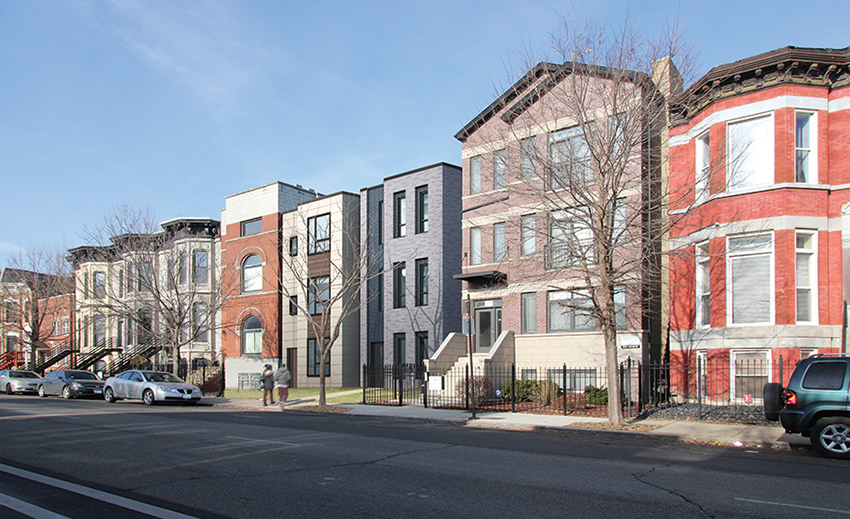
VANCOUVER AFFORDABLE HOUSING AUTHORITY/MARK SIMPSON
In addition to a series of projects based on Chicago’s “three-flat” typology (rendering, above), Skender has six mid-rise buildings in design.
In addition to a series of infill projects based on Chicago’s “three-flat” typology, the company now has six mid-rise projects, ranging between four and 12 stories, in design. These include an 11-story, 110,000-square-foot mixed-use building with eight stories of modular housing on top of a site-built concrete podium and parking structure. From the time the podium is ready until all modular stories are set and bolted in place will take just seven and a half weeks. Joints between the volumes will then be sealed to maintain a continuous air and vapor barrier, a high-performance metal-panel facade will be applied, and cross-unit connections will be completed inside—a couple of months more in total.
Demonstrating what’s possible when a municipality fast-tracks an inherently fast production method, the housing authority of the city of Vancouver, British Columbia, recently developed 606 dwelling units for the formerly homeless in 13 buildings on 10 different sites in less than 18 months. That’s from the architects’ first meeting with the city to the last occupant permit’s being issued, says Anthony Boni, a principal with local Boni Maddison Architects, authors with design-builder Horizon North of all 13 projects. “Although speed was the main reason for choosing modular construction,” says Boni, “prefabrication gave us a major advantage in reducing disruption on-site,” especially useful when inserting a not always welcome use into existing neighborhoods. “We’ve had no complaints,” he says.
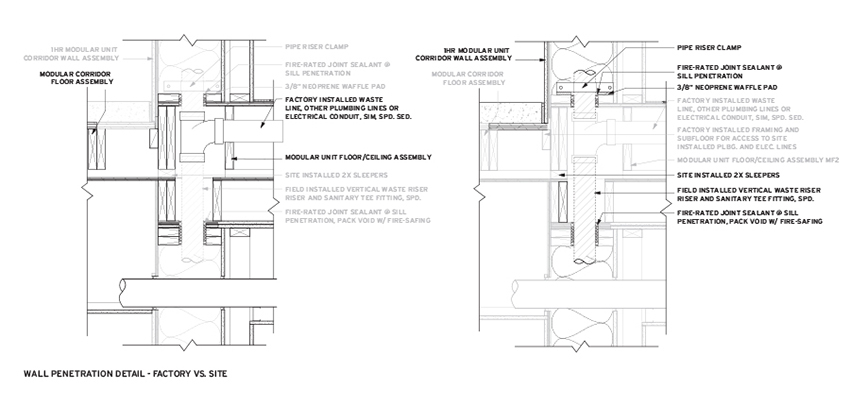
IMAGES: COURTESY SKENDER; DAVID BAKER ARCHITECTS
David Baker Associates uses side-by-side diagrams to distinguish work completed in the factory from that performed in the field. In one, the site work is ghosted to highlight the factory scope (above, left), while the other does the reverse (above, right).
The firm designed a prototypical building using wood-framed volumetric construction that could be replicated across multiple sites. It comprises 52 320-square-foot units on three stories. Intended to be demountable and relocatable to allow for temporary installations while longer-term plans for a site evolve, the buildings use a space-frame foundation system to save the time—and cost—of extensive site work. As well as shelter, each building provides support services to help residents change the circumstances that led to their homelessness. Facade accents in yellow highlight common areas such as kitchens, dining and social rooms, and other support spaces.
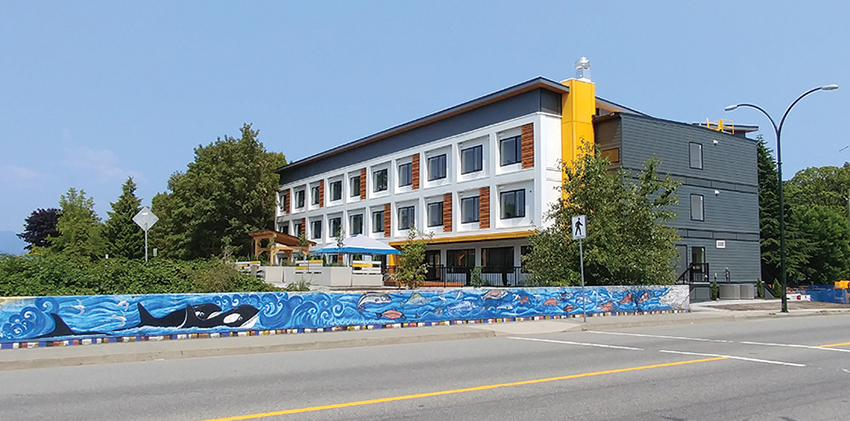
IMAGE: COURTESY SKENDER; DAVID BAKER ARCHITECTS
Boni Maddison Architects has developed more than 600 units for the formerly homeless on 10 different sites in Vancouver. The projects, which depend on wood-framed volumetric construction, were completed in less than 18 months.
In addition to their rapid response, it might be expected that modular units would also save money. But Boni reports that these projects came in at costs comparable to site-built. At David Baker Architects (DBA), a San Francisco–based firm with more than a decade’s experience with modular construction, associate Brad Leibin says that savings from prefabrication typically amount to five to 10 percent of total project costs, although Larry Pace, COO at Factory OS, a Bay Area volumetric prefabricator, reports savings of as much as 20 percent of total costs, as does Skender.
The challenge is that, even though prefabricated components account for most of the superstructure, other elements, such as site work, foundation, on-site connections, and exterior finishes, typically account for about two-thirds of total project costs, says Leibin; “Achieving savings with modular construction depends in large part on designing to minimize site work.” A key strategy is to minimize connections across modules—and therefore on-site patchwork and additional trades and traffic. If a one-bedroom apartment, for example, consists of two volumetric modules side by side, configuring the program so that the seam between the two modules is primarily wall (rather than the middle of a room, say, or lots of doorways and cross-unit service connections) reduces the need for on-site finishing. Understanding the way units will be built is essential from the outset, as is a prototype before fabrication starts.
Clearly distinguishing work to be performed in the factory from work to be completed on-site is another way to keep costs down. If a drawing contains both types of scope, DBA typically provides side-by-side versions, one graying out the factory work to highlight the on-site scope, and the other doing the reverse. This way, state officials reviewing prefabricated components and municipal regulators reviewing site work (which is how approvals for modular construction are structured in California) can see their scope clearly, and trades who may be unfamiliar with prefabrication don’t feel the need to allow for uncertainties by overbidding.
“At least half of the clients coming through our door are interested in the possibility of modular,” says Leibin. The firm works with them to assess whether their project and prefabrication are a good fit, evaluating factors such as financing timelines (prefabrication typically requires capital earlier in the process), cost- and time-saving opportunities, and site constraints (such as whether streets are wide enough to accommodate volumetric modules and whether there’s an appropriate staging area nearby). “Our goal is the best building possible within a given budget,” says Leibin, “and modular construction is a possible tool for achieving that.”
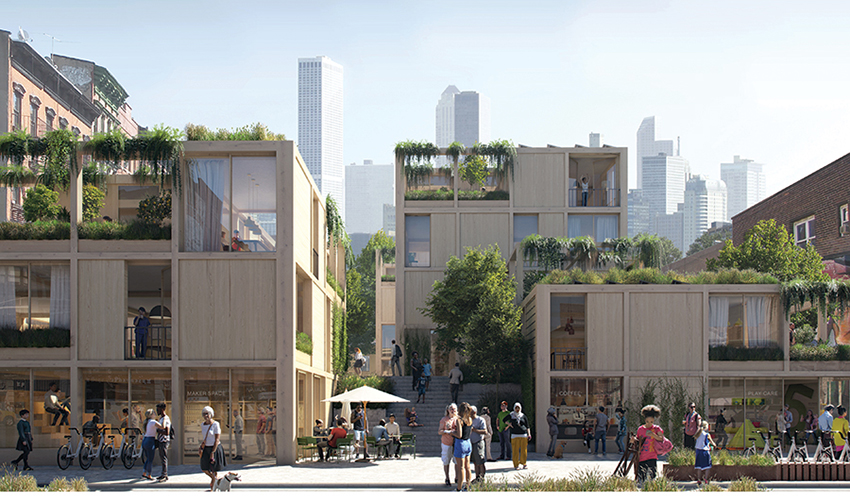

RENDERINGS: BY EFFEKT ARCHITECTS FOR SPACE10
The Urban Village system developed by EFFEKT and SPACE10 is intended to be adaptable to different site conditions and varying scales, including an urban infill building (above) and a city district (top).
In one of the most comprehensive approaches to prefabrication so far, EFFEKT Architects’ IKEA-funded design leverages the potential of modular housing to tackle multiple aspects of the housing crisis head on. “We’ve seen a wide range of sustainable projects that are not affordable and maybe not livable, cities that are consistently ranked most livable, but are neither sustainable nor affordable, and a long tradition of affordable housing that is neither livable nor sustainable,” says Sinus Lynge. “We believe that unless you combine all three, you don’t really crack the code. That’s what we’re trying to do with this project.”
The resulting scheme for the Urban Village Project consists of a mass-timber system that can be configured to achieve site-specific projects of varying scales, from a single infill building to community-scale developments of 50 units or so, and even projects comprising multiple communities. Interchangeable facade elements—windows, balconies, and wall panels—generate variety, while their mechanical connections facilitate retrofitting and reuse in a circular supply chain. Shared spaces and resources foster community, and a range of apartment sizes and configurations supports diverse household types and aging in place.
Beyond the building fabric, the scheme addresses affordability with a financing model targeted toward long-term investors, as well as an innovative “subscription” program. At a minimum, residents subscribe to a monthly rate that includes such essentials as rent, utilities, and maintenance. In addition, they can choose to subscribe to deals on food, media, insurance, transportation, and recreation. And they also have the option each month of buying shares in the development, accessing ownership progressively without the need to accumulate what’s often a prohibitive down payment or to pay interest on a mortgage.
The Urban Village Project is now out for feedback and expressions of interest from investors, developers, municipalities, and the public, with a prototype scheduled for later this year. “The ambition is to rethink the way we build modular,” says Lynge—an aspiration that resonates among the growing number of architects and industry professionals who think the housing sector is ripe for this change.
Katharine Logan is an architectural designer and writer focusing on design, sustainability, and well-being.
Supplemental Materials
Modular Construction: From Projects to Products; McKinsey & Company, June 2019; Nick Bertram, Steffen Fuchs, Jan Mischke, Robert Palter, Gernot Strube, and Jonathan Woetzel; “In brief,” (page 1) and “Modular has had its moment before, but there is reason to believe its momentum is sustainable this time,”(pages 17 through 19).
